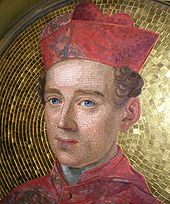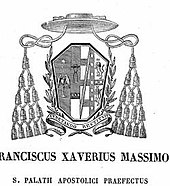Francesco Saverio Massimo
Francesco Saverio Massimo also Franz Xaver Massimo (born February 26, 1806 in Dresden , † January 11, 1848 in Rome ) was a German-Italian Curia Cardinal , papal Maior Domus, prefect of the Apostolic Palace and confidant of Pope Gregory XVI. ; on his mother's side he came from the Saxon ruling house of the Wettins .
Life
The mother of the future Cardinal Francesco Saverio Massimo was the German Princess Christine von Sachsen, Countess von der Lausitz, daughter of Prince Franz Xaver von Sachsen , his father the Italians Camillo Massimiliano Massimo, Marquis de Roccasecca, 1st Principe di Arsoli.
The boy - one of his parents' six children - was born in Dresden and grew up in Rome, where he entered the clergy and rose very quickly due to his high talent and princely descent. In 1837 his mother died of cholera in Rome .
Pope Gregory XVI called the young priest to the Curia and his immediate vicinity. He made him his chamberlain and personal Maior Domus (head of the household), later prefect of the Apostolic Palace . In the consistory of February 12, 1838, he appointed him cardinal in pectore , without publication of the creation. The cardinal's uprising was published in the consistory of January 24, 1842, on January 27, Francesco Saverio Massimo received the red cardinal's hat as cardinal deacon and the title deaconry Santa Maria in Domnica .
On March 11, 1843, the cardinal entered the service of Propaganda Fide , and on November 14, he was promoted to papal legate in Ravenna . Here he wrote a report that has become famous in 1845, in which he relentlessly realistically reveals the growing alienation of society from the papal government. He writes u. a .:
“ Your Excellency requires me to report on the situation and on the mood of the bulk of the population towards the government. I must explain to you that the cause of the altar and throne has grown to truly deplorable proportions. The seed scattered by French rule, the aim of which was the abolition of papal government and spiritual goods, has since grown so that there are no longer any limits, even to shame. Unless permanent facts are concerned, which can always victoriously answer doubt, one might be decent to communicate them in order not to be considered exaggerated. But the naughtiness in all classes, from the patrician to the boy in the workshop, who are always for crime and for the criminal, in that, to the disgrace of the government, they practice common interests, their relationships and their stock markets; the smuggling practiced here in every city like an armed force; the daily assassinations of the few loyal officials as victims of party hatred; the generally torn intimidation by virtue of the drawn dagger, which silences the witness evidence, so that as a rule every wrongdoing goes unpunished, the mockery of religion, the blasphemy common even in the mouths of children: all this in abundance proves the general political and moral corruption . In addition, there is the pride of the inhabitants of this province (Romagna), who, greatly overestimating themselves and their country, makes it unbearable for them to obey what they call priestly government. The present generation must be given up for lost; one must continually struggle with it. The principles of moral instruction must be taken up again for the new generation. Suffice it to say that, with the exception of the old people, the young people who are just growing up in the cities, and a very small part of the not entirely spoiled agricultural population, all the rest of the population of over eighteen years of age, are generally hostile to the government. With this I have given your Excellency my opinion, in accordance with your request, with full sincerity, with the removal of every veil. "
Francesco Saverio Massimo participated in the conclave of 1846 that Pope Pius IX. chose. The new Pope also related the prelate in the curia. He moved to the administration of the Papal States , where he headed the Congregation for Water and Roads, so was quasi Transport and Water Minister of the Papal State.
The cardinal died on January 11, 1848 in Rome at the age of 42. On the 15th of the month the funeral ceremonies took place, at which Pope Pius IX. took place in the Roman basilica of San Lorenzo in Damaso . The prelate of the Curia was buried in the family tomb of the Roman noble family Massimo, which is located in a chapel of the church.
effect
In his Roman memories Journey from La Trappe to Rome , the Trappist abbot Ferdinand von Geramb , who met Massimo in 1838 on the occasion of an audience with the Pope, wrote the following about him:
"[...] besides the noble guard and several prelates from the service, the chamberlain of His Holiness, who is always on duty, is always present. This was Mr. Massimo, a very talkative and immensely informed prelate who belongs to one of the oldest families in Rome. His mother, a princess of Saxony, died of cholera. The position of a chamberlain leads to cardinal dignity. "
The Irish magazine Dublin Review reported in its May 1840 edition that in the Good Friday liturgy in St. Peter's Basilica in Rome that year a valuable cross relic from the property of Pope Leo the Great was venerated, which was believed to have been lost, but shortly before by the papal major Domus, Monsignor Massimo, was found again.
literature
- Tommaso di Carpegna Falconieri: Massimo, Francesco Saverio. In: Mario Caravale (ed.): Dizionario Biografico degli Italiani (DBI). Volume 72: Massimino-Mechetti. Istituto della Enciclopedia Italiana, Rome 2009.
Web links
- Entry on Francesco Saverio Massimo on catholic-hierarchy.org ; accessed on July 28, 2016.
- Massimo, Francesco Saverio. In: Salvador Miranda : The Cardinals of the Holy Roman Church. ( Florida International University website), accessed July 28, 2016. (English)
Individual evidence
- ^ Pius Gams, Antoine-Henri de Bérault-Bercastel: History of the Church of Christ in the nineteenth century, with special consideration for Germany. Volume 2. Wagner, Innsbruck 1855, p. 579, full text in the Google book search
- ^ The Dublin Review , May 1840, p. 570 in Google Book Search
| personal data | |
|---|---|
| SURNAME | Massimo, Francesco Saverio |
| ALTERNATIVE NAMES | Massimo, Franz Xaver |
| BRIEF DESCRIPTION | Cardinal of the Curia, from the Saxon royal family |
| DATE OF BIRTH | February 26, 1806 |
| PLACE OF BIRTH | Dresden |
| DATE OF DEATH | January 11, 1848 |
| Place of death | Rome |


